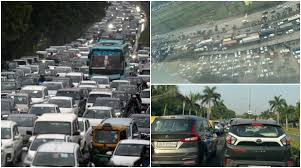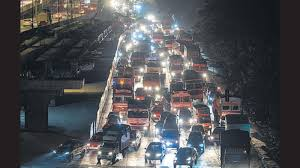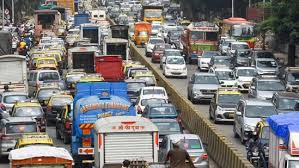Watch how a massive traffic jam on the Mumbai-Ahmedabad highway brought vehicles to a standstill overnight, forcing hundreds of students to sleep in buses as rescue efforts stretched into the early hours
A severe traffic jam brought the Mumbai-Ahmedabad highway—a vital artery connecting two of India’s busiest metros—to a near standstill late last night. The jam stretched for several kilometers and caused massive delays, forcing hundreds of stranded travelers, especially students, to spend the night inside their buses and vehicles on the highway.
The jam not only caused immense inconvenience but also raised questions about highway infrastructure, emergency response, and traffic management in one of India’s most critical road corridors.
What Happened: The Cause of the Jam
The Mumbai-Ahmedabad highway, part of the larger Golden Quadrilateral project, is one of the busiest and most important highways in India. It facilitates heavy commercial and passenger traffic daily. Last night, the highway witnessed a massive traffic jam that lasted nearly 12 hours, starting at around 7 pm.
Authorities reported that the jam was primarily triggered by a multi-vehicle accident involving two trucks and a private bus near the Vadodara bypass section. The accident blocked two lanes and caused traffic to come to a grinding halt. Compounding the problem, ongoing road repair work and monsoon-related waterlogging at a nearby stretch further slowed down the clearance efforts.
The jam stretched over 20 kilometers, affecting traffic in both directions. Vehicles were reportedly moving at a snail’s pace, with some stationary for hours.
Hundreds of Students Stranded Overnight

One of the most poignant aspects of this traffic crisis was the plight of hundreds of students who were traveling home after various academic events, coaching classes, and extracurricular activities in Mumbai and Ahmedabad.
Many students were on school and college buses, which became virtual shelters overnight. With nowhere else to go and no immediate alternatives, these students had to spend the entire night inside their vehicles on the highway, some sharing snacks, some trying to catch sleep, others making the best of a tough situation by playing games or chatting.
Parents and families of these students expressed worry and concern, with some calling helplines or trying to reach officials for information.
Firsthand Accounts from Stranded Passengers
Several students and bus drivers shared their experiences:
- Rohit Sharma, a college student traveling from Ahmedabad to Mumbai, said, “We got stuck in the jam around 9 pm. There was no way to get off the bus. The roads were packed, and buses were lined up for kilometers. We had to stay awake most of the night, but the bus driver kept us calm.”
- Neha Patel, a school student on a coaching bus, added, “It was scary at first, but the bus conductor made sure everyone was safe and had water. Some teachers even played songs to lighten the mood.”
- A bus driver, Mohan Kumar, stated, “We were stuck with no facilities. Most buses didn’t have enough food or water. It was tough managing kids overnight, but we did our best.”
Emergency Response and Relief Measures
Local authorities and the National Highway Traffic Police (NHTP) were quick to respond, dispatching rescue vehicles, ambulances, and food supplies as soon as the jam was reported.
A temporary relief camp was set up near the accident site where water, snacks, and basic medical aid were provided. Traffic police also coordinated with bus companies and transport unions to provide alternate arrangements where possible.
The fire brigade and road safety teams worked through the night to clear the accident wreckage and manage the waterlogging situation, enabling partial reopening of lanes by early morning.
Despite these efforts, officials admitted that the scale of the jam was unprecedented in recent years and emphasized the need for better infrastructure and emergency preparedness.
Infrastructure Challenges: Why Do Such Jams Happen?
Experts and urban planners say this traffic jam highlights deeper infrastructural challenges:

- Inadequate Road Capacity: The Mumbai-Ahmedabad highway, despite upgrades, is facing increasing vehicular loads beyond its capacity, especially during monsoons.
- Maintenance and Repair Timing: Roadworks often happen during peak traffic hours, causing avoidable bottlenecks.
- Accident Management: Delays in clearing accident sites contribute heavily to traffic congestion.
- Lack of Alternate Routes: With limited parallel highways or bypasses, all traffic is funneled into the same corridor.
- Monsoon Impact: Waterlogging due to poor drainage exacerbates traffic slowdowns.
Official Statements and Future Plans
In response to public outcry and media attention, the Ministry of Road Transport and Highways (MoRTH) issued a statement promising:
- An investigation into the incident and response delays.
- Plans to upgrade key bottleneck sections of the highway, including widening and improved drainage.
- Coordination with local authorities to schedule road maintenance during low-traffic hours.
- Exploration of alternate routes to divert traffic during emergencies.
A senior official from the National Highway Authority of India (NHAI) said, “We deeply regret the inconvenience caused. Steps are underway to improve infrastructure and emergency response. Such incidents highlight the urgent need for systemic upgrades.”
Impact on Daily Commuters and Economy
The Mumbai-Ahmedabad corridor is vital not only for personal travel but also for trade and commerce. Delays and jams have a ripple effect on the supply chain, delivery schedules, and business operations.
- Transporters and truck drivers faced huge delays, leading to increased costs.
- Small businesses and vendors relying on timely shipments experienced disruptions.
- Local tourism and hospitality sectors reported cancellations and lost revenue.
Experts estimate that such jams cause losses of several crores of rupees daily to the regional economy.
Tips for Travelers: How to Avoid or Prepare for Highway Jams
Given the challenges, travelers can take precautions:
- Check traffic updates regularly via apps like Google Maps or local traffic bulletins.
- Avoid travel during peak monsoon hours or when road repair is underway.
- Carry essentials such as water, snacks, and medications in case of delays.
- Plan alternate routes if possible.
- Stay calm and patient—help others around and follow official instructions.
Voices from Social Media
Social media platforms were abuzz last night as stranded travelers shared photos and videos of the jam, the buses lined up, and the rainy weather.
Hashtags like #MumbaiAhmedabadJam, #StrandedStudents, and #HighwayChaos trended briefly on Twitter and Instagram.
Netizens expressed sympathy and frustration, urging authorities to improve road infrastructure and emergency services.
Conclusion: Lessons and the Way Forward
The massive traffic jam on the Mumbai-Ahmedabad highway was a stark reminder of the challenges faced by India’s transport infrastructure amid growing demand. While authorities responded with urgency, the ordeal suffered by hundreds of students and travelers underscored the need for proactive planning, better infrastructure, and smarter traffic management.
With the government’s renewed focus on highway upgrades and technological interventions, there is hope that such incidents will become less frequent.
Meanwhile, the resilience of stranded students and drivers, who managed to stay safe and supportive overnight despite difficult conditions, is a testament to human spirit in adversity.
Also Read : How A Paan Stall Helped Vivek Oberoi Build His Rs 1,200-Crore Wealth















 Categories
Categories








